Small daisies polka-dot the area where the farmer lane crosses the gravel road. These pretty little flowers seem to enjoy the sunshine because that’s where they’re growing and blooming in all their glory. Until I stopped to really take a look at these asters, I didn’t realize two different kinds were growing side-by-side.
One aster was taller than the other and it had larger blooms, too.
The tall “roadside weed” is called Panicled Aster, Aster simplex, and reaches 6 feet tall. The sturdy stems grow straight up through the growing season, but at some point they arch over to nearly touch the ground.
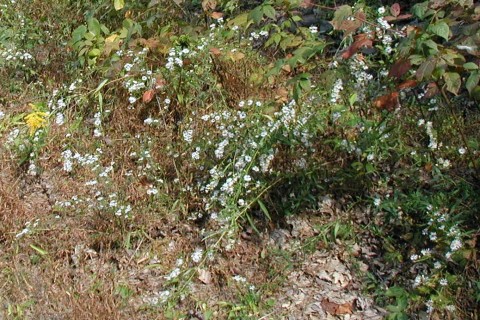
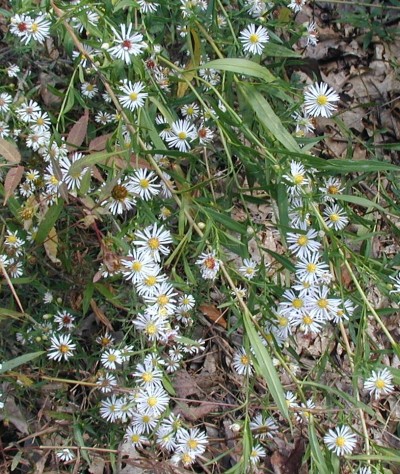
While blooming the Panicled Aster looks like broad arches of white blooms. Side stems have blooms in panicle fashion. Photos taken 6OCT08.

Panicled Aster blooms measure an inch or more across.
One identifying characteristic of this aster is the way the leaves clasp the stems. Side branches that arise from the leaf axils are totally enveloped by the clasping leaf.
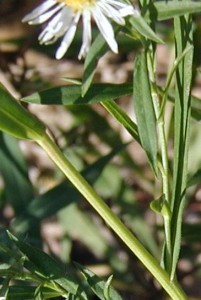
Panicled Aster leaves are narrowly lance-shaped and clasp the stem.
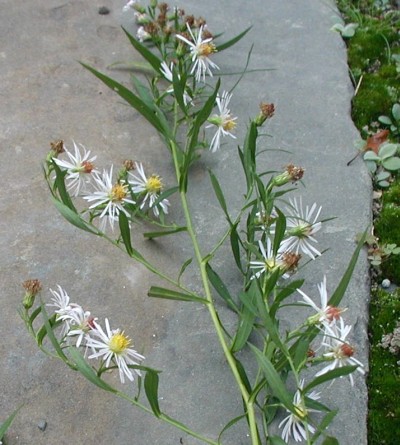
Flower arrangement of Panicled Aster.
The second aster had smaller blossoms less than one half-inch across and overall it appeared to be a smaller plant. Leaves were shorter, ray flowers were shorter and the plant stood only two feet tall. “Petals” or ray flowers numbered about 20, instead of 30 as in the Panicled Aster.
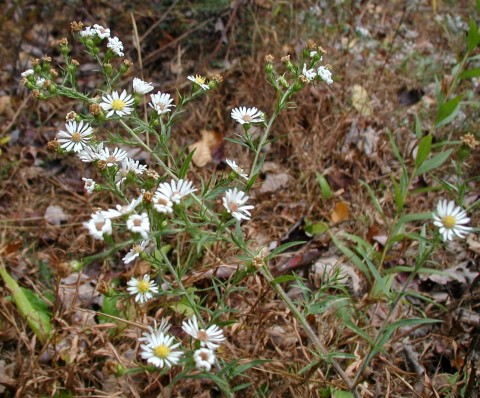
Small white aster flower arrangement.
Didn’t get a decent photo to illustrate, but the small aster flower bracts have short threads that are noticeably green and flare out from the flower base. Fuzzy stems were also noted on the small-flowered aster, while the Panicled Aster stems were smooth.
Unfortunately, my field guides describe only a handful of asters. Audubon’s Wildflower Guide notes that the Panicled Aster has several varieties that differ “in color, size of the ray flowers, leaf form, and serration.” So, perhaps the small flowered aster is not a separate species, but a variety of Panicled Aster.
I would think that having smaller blooms, fewer and smaller ray flowers, shorter stature and a hairy stem are too many characteristics that are not shared with the larger Panicled Aster for the small-flowered aster to be a variety of it.
Peterson and McKenny note that there are many small white asters and that they intergrade. They conclude, and I agree, that distinguishing the different Aster species should be left up to the experts.
For now, we’ll call it the Small-flowered White Aster, Aster vimineus, as it has small flowers, fewer ray flowers and green tipped bracts beneath the flower heads.
Neither of these asters have any edible or medicinal qualities, but I still enjoy seeing them smiling at me from across the lane.
If you’d like to read more about identifying wild herbs and wildflowers, you’ll need to pick a field guide or two. Start with Newcomb’s Wildflower Guide and see the side panel for my other recommendations.